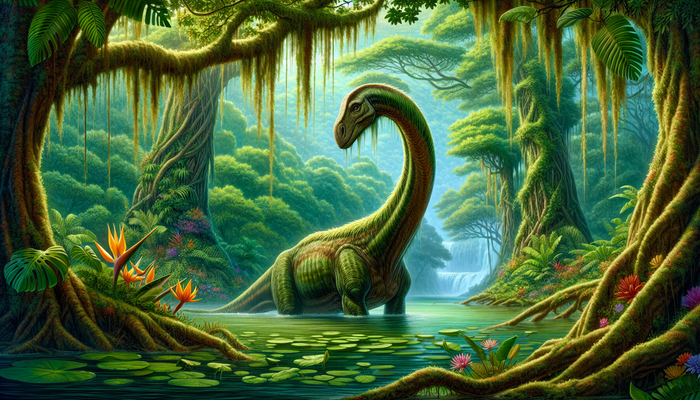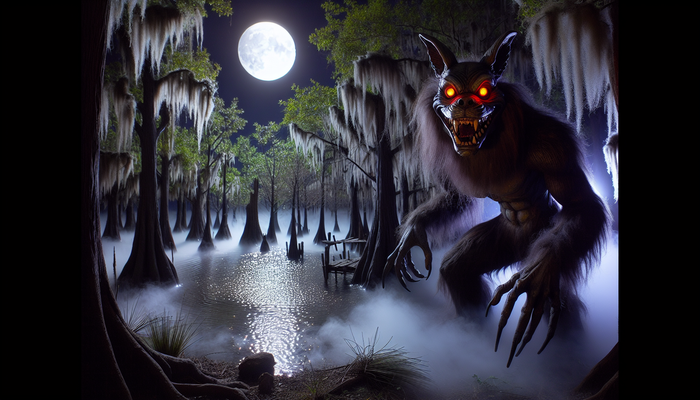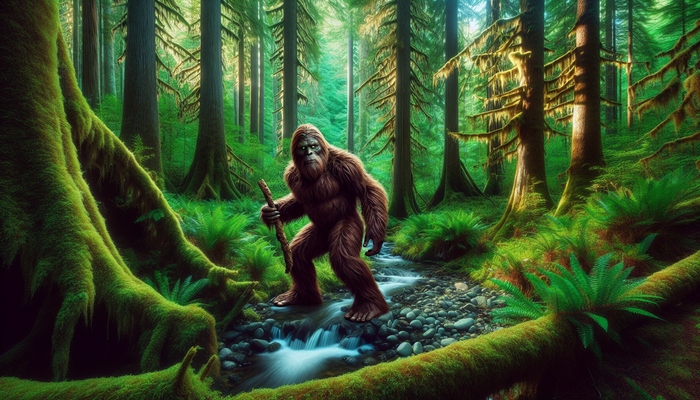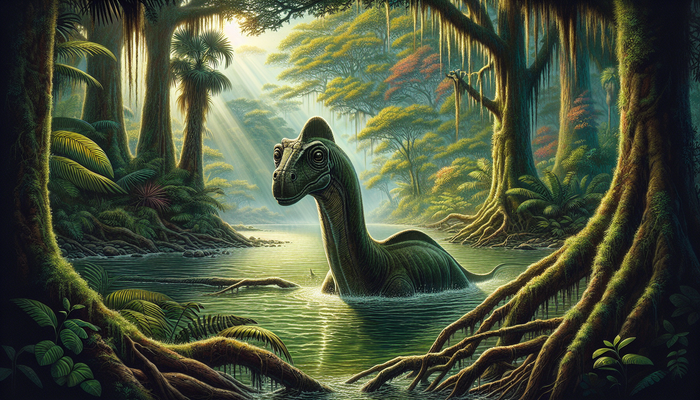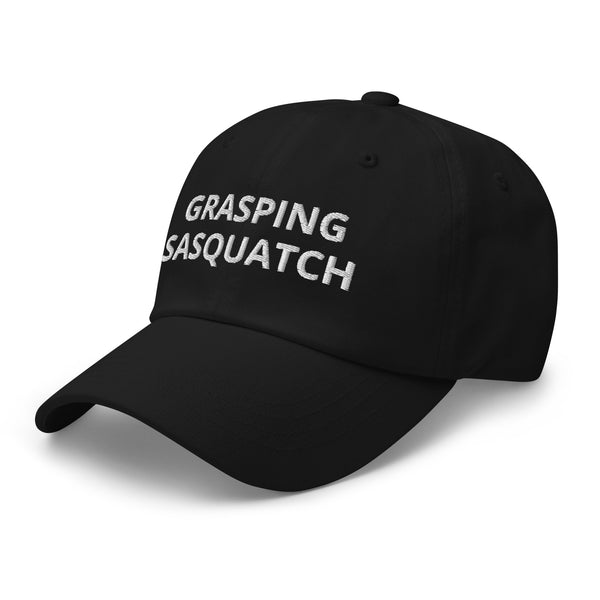The Bunyip: Connecting Australian Aboriginal Legends and Cryptids
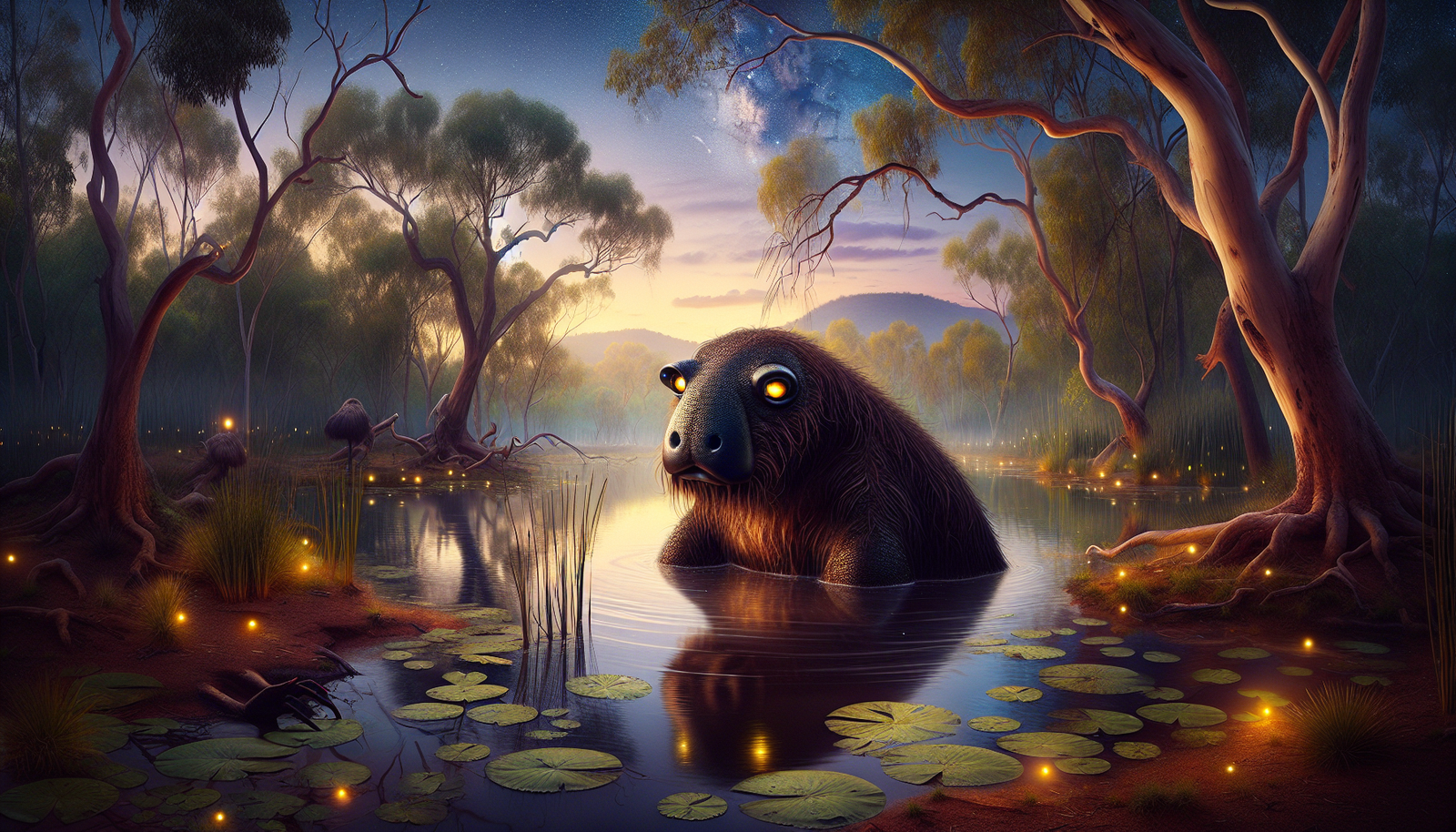
By Oliver Bennett, Cryptozoologist
The Origins of the Bunyip Legend
The word "Bunyip" itself is a linguistic puzzle, a whisper from the past that echoes through the ages. Its roots stretch deep into the soil of Aboriginal Australia, specifically to the Wemba-Wemba language of Victoria. But like the creature it describes, the word's meaning is slippery, defying simple translation.
Many have tried to pin it down as "devil" or "evil spirit," but these interpretations are as muddy as the waters the Bunyip is said to inhabit. The truth is, the Bunyip's significance in Aboriginal culture is far more nuanced and profound than these simplistic labels suggest.
To truly understand the Bunyip, we must immerse ourselves in the concept of the Dreamtime, the spiritual foundation of Aboriginal culture. The Dreamtime isn't just a creation myth; it's a living, breathing worldview that shapes every aspect of traditional Aboriginal life. In this rich tapestry of belief, the Bunyip emerges not as a mere monster, but as a powerful water spirit, a guardian of the natural world, and a teacher of vital ecological lessons.
Imagine, if you will, the first Aboriginal storytellers sitting around a fire, their voices carrying tales of the Bunyip across the vast Australian night. These weren't just campfire ghost stories; they were sophisticated narratives that encoded crucial information about the environment, proper behavior, and the delicate balance of nature.
In some Dreamtime stories, the Bunyip plays a role in shaping the very landscape itself. Its movements carve out riverbeds and create billabongs, leaving an indelible mark on the country. This isn't just fanciful myth-making; it's a way of understanding and remembering the formation of the land, a geological history wrapped in the cloak of legend.
But the Bunyip isn't just a force of nature; it's also a moral arbiter. Many tales cast it as a punisher of those who take more than their fair share from the waterways or who disrespect the delicate ecosystems it guards. In this way, the Bunyip serves as a powerful symbol of environmental stewardship, a concept that resonates just as strongly today as it did thousands of years ago.
The genius of the Bunyip legend lies in its adaptability. Each Aboriginal group has its own version of the creature, tailored to the specific environment and needs of their territory. This diversity of interpretation speaks to the creature's importance as a cultural touchstone, one that could be molded to fit the unique circumstances of each community while still maintaining its core essence as a powerful water spirit.
As we unravel the origins of the Bunyip, we begin to see it not as a single, fixed entity, but as a fluid concept that flows through the veins of Aboriginal culture, carrying with it the lifeblood of ancient wisdom and ecological knowledge. It's a creature born from the land itself, as varied and vast as the Australian continent it inhabits.
Descriptions and Variations of the Bunyip
Picture, if you can, a creature that defies easy description, a beast that shifts and changes like the play of sunlight on water. This is the Bunyip, a shape-shifter extraordinaire that has confounded attempts at categorization for centuries. Its physical form is as varied as the landscapes it's said to inhabit, a testament to the rich imagination of Aboriginal storytellers and the diverse environments of Australia.
In some tales, the Bunyip looms large, a behemoth that dwarfs a horse, its massive bulk sending ripples across the surface of still waters. Other stories paint it as a more modest creature, perhaps the size of a large dog, but no less fearsome for its smaller stature. This variability in size isn't just a quirk of storytelling; it reflects the Bunyip's ability to adapt to different waterways, from sprawling rivers to intimate billabongs.
The Bunyip's body is a marvel of aquatic engineering, perfectly suited to its watery domain. Imagine powerful limbs propelling it through the depths with effortless grace, its movements as smooth and silent as a shadow. Some descriptions give it flippers or webbed feet, emphasizing its mastery over its liquid realm.
But it's the Bunyip's head that truly captures the imagination. Here, the descriptions become a wild menagerie of features, a biological impossibility that speaks to the creature's supernatural nature. Some tales give it the face of a dog, with sharp teeth gleaming in the moonlight and a powerful jaw that could snap a canoe like a twig. Others describe a more equine visage, with large, expressive eyes that seem to hold the wisdom of ages.
Perhaps most striking are the accounts that lend the Bunyip an emu-like appearance, with a long, sinuous neck topped by a bird-like head. This avian aspect isn't just a flight of fancy; it connects the Bunyip to the broader tapestry of Australian wildlife, blending the familiar with the fantastic.
The Bunyip's eyes are a feature that many stories linger on, describing them as glowing with an otherworldly light. Imagine those eyes piercing the darkness of a swamp, the only indication of the creature's presence until it's too late. It's a chilling image that has no doubt kept many a traveler away from unknown waters after nightfall.
The creature's body covering is another point of fascination and disagreement. Some describe it as cloaked in dark fur, matted and tangled with swamp weeds, a living embodiment of its murky home. Others give it a more reptilian aspect, with scales that glisten wetly in the moonlight. There are even accounts that blend these features, creating a chimera-like being that seems to embody all the mystery and danger of the Australian wilderness.
But perhaps the most intriguing descriptions are those that defy all expectations. Some Aboriginal stories speak of a Bunyip that resembles nothing so much as a giant starfish, its arms radiating out from a central body in a way that's both alien and oddly beautiful. This version of the Bunyip speaks to the creature's connection to the deepest, most primordial aspects of water lore.
The Bunyip's call is another aspect that varies widely in the telling, but always leaves a lasting impression. Some describe it as a booming cry that echoes across the landscape, a sound so powerful it seems to shake the very earth. Others speak of more subtle vocalizations: the lapping of water against a hidden shore, or a low, ominous growl that sends shivers down the spine.
These diverse descriptions aren't just the result of overactive imaginations or exaggeration. They reflect the Bunyip's role as a creature of the Dreamtime, a being that exists beyond the confines of ordinary reality. Its ability to change form speaks to its power as a spirit being, one that can adapt to the needs of different stories and different landscapes.
Moreover, the variety in the Bunyip's appearance reflects the diversity of Australia's waterways and the creatures that inhabit them. From the crocodiles of the north to the seals that occasionally venture inland in the south, the Bunyip seems to incorporate aspects of all of Australia's aquatic life, blended into a single, awe-inspiring entity.
As we contemplate these myriad descriptions, we're left with a creature that's both everywhere and nowhere, a phantom that slips through the fingers of definition even as it looms large in the cultural imagination. The Bunyip, in all its varied forms, serves as a powerful reminder of the mystery and majesty of the natural world, a being that commands respect and inspires wonder in equal measure.
Cultural Significance of the Bunyip
The Bunyip is far more than a simple boogeyman used to frighten children away from dangerous waters. It's a complex cultural symbol that embodies deep truths about the relationship between humans, nature, and the spirit world in Aboriginal Australian traditions.
At its core, the Bunyip serves as a guardian of waterways, a role of paramount importance in a land where water is often scarce and always precious. Imagine the Bunyip as a spiritual custodian, keeping watch over billabongs, rivers, and swamps with an unwavering vigilance. This isn't just about protecting water as a resource; it's about maintaining the delicate balance of entire ecosystems.
In many Aboriginal stories, the Bunyip acts as a deterrent against overexploitation. Those who take more fish than they need or pollute the waters risk incurring the creature's wrath. It's a powerful metaphor for the consequences of environmental disrespect, one that resonates strongly in our current era of ecological crisis.
Consider the tale of the Mulgawonk, a Bunyip-like creature from the lore of the Ngarrindjeri people of South Australia. The Mulgawonk was said to punish those who overfished or mistreated the waters of the Murray River. This story isn't just a quaint folk tale; it's a sophisticated piece of environmental education, teaching sustainable practices wrapped in the guise of a monster story.
The Bunyip also plays a crucial role in Aboriginal spirituality, acting as a bridge between the physical and spiritual realms. In many Dreamtime stories, the Bunyip is portrayed as a being that can move between worlds, carrying messages from the ancestors and enforcing the laws of nature. This spiritual aspect elevates the Bunyip from mere creature to a powerful symbol of the interconnectedness of all things.
As a teaching tool, Bunyip stories are unparalleled. They serve as a means of cultural education, passing down important knowledge from generation to generation. These tales aren't just entertainment; they're a curriculum in ecological awareness, respect for tradition, and the consequences of disregarding ancestral wisdom.
Imagine a young Aboriginal child listening wide-eyed to stories of the Bunyip. Through these narratives, they learn not just to fear unknown waters, but to respect them. They absorb lessons about the importance of taking only what's needed, of living in harmony with the land, and of honoring the spirits that dwell in every aspect of the natural world.
The Bunyip also embodies the concept of the unknown and mysterious in nature. In a land as vast and varied as Australia, there are always places beyond the edge of human knowledge. The Bunyip represents this sense of wonder and respect for the unexplored, reminding us that nature always has secrets to reveal.
In Aboriginal art, the Bunyip takes on many forms, appearing in rock paintings, bark art, and modern works. These depictions aren't just artistic expressions; they're a way of keeping the Bunyip's lessons alive, of continually renewing its relevance in a changing world.
Interestingly, the Bunyip has also found its way into initiation rites and coming-of-age ceremonies in some Aboriginal communities. Facing the Bunyip, whether literally or metaphorically, becomes a test of courage and a rite of passage. It's a powerful way of instilling respect for nature and tradition in the next generation.
As Australia has evolved, so too has the cultural significance of the Bunyip. It's become a symbol of national identity, a uniquely Australian icon that speaks to the country's wild heart. The Bunyip has appeared on postage stamps, in literature, and as mascots for environmental conservation efforts. It's a testament to the enduring power of this legend that it continues to resonate in modern Australian society.
Even in language, the Bunyip has left its mark. The term has entered Australian English as a way to describe something mythical or hard to believe. Phrases like "Bunyip aristocracy" have been used in political discourse, showing how deeply the concept has permeated the national psyche.
The cultural significance of the Bunyip lies in its ability to adapt and evolve while still maintaining its core essence. It's a symbol that speaks to both the ancient wisdom of the Aboriginal people and the modern Australian identity. In the Bunyip, we see reflected our complex relationship with the natural world, our respect for the unknown, and our ongoing struggle to live in harmony with the land.
As we face global environmental challenges, the lessons embedded in Bunyip lore become ever more relevant. Perhaps, in reconnecting with these ancient stories, we can find new ways to address the ecological issues of our time. The Bunyip, in all its mysterious glory, continues to serve as a powerful reminder of our responsibility to the natural world and to the wisdom of those who came before us.
European Encounters and Misinterpretations
When European settlers first set foot on Australian soil, they entered a world unlike anything they had ever known. The landscape was alien, the wildlife bizarre, and the indigenous culture utterly foreign. Into this maelstrom of the unfamiliar came tales of the Bunyip, a creature that would capture the colonial imagination and lead to a fascinating cultural exchange – and misunderstanding.
Imagine the scene: a group of British colonists, fresh off the boat, listening wide-eyed as an Aboriginal elder speaks of a fearsome creature that lurks in the waterways. The settlers, already grappling with the existence of kangaroos and platypuses, found themselves confronted with yet another Australian oddity. But unlike the tangible wildlife they could see and touch, the Bunyip remained elusive, a phantom that fired their imaginations and fueled their fears.
The initial European reaction to Bunyip tales was a mixture of fascination and skepticism. Many settlers, steeped in the rationalist thinking of the Enlightenment, were quick to dismiss the Bunyip as mere superstition. Others, however, were more open to the possibility of undiscovered creatures in this strange new land.
One of the most notable early encounters with the Bunyip legend came from William Buckley, an escaped convict who lived among the Wathaurong people for 32 years. In his 1852 biography, Buckley recounted several encounters with what he called the Bunyip. He described it as "a very extraordinary amphibious animal" with a back "covered with feathers of a dusky grey color."
Buckley's account is fascinating not just for its description of the creature, but for what it reveals about the cultural exchange taking place. Here was a European man who had immersed himself in Aboriginal culture, returning to white society with tales that blended indigenous knowledge with his own interpretations. His story became a bridge between two worlds, albeit one that was often misunderstood on both sides.
The 1845 article in the Geelong Advertiser titled "The Bunyip, or Kine Pratie" marked a turning point in the European engagement with the Bunyip legend. The article reported on the discovery of fossilized remains that were purportedly identified by an Aboriginal man as belonging to a Bunyip. This incident sparked a flurry of interest and "sightings" across the colonies.
What's particularly interesting about this episode is how it reveals the colonial mindset at work. The settlers, eager to make sense of their new environment, latched onto the idea of the Bunyip as a real, undiscovered animal. They attempted to fit it into their scientific worldview, comparing it to known creatures like seals or extinct megafauna.
This scientific approach to the Bunyip reached its peak with the exhibition of a supposed "Bunyip skull" at the Australian Museum in Sydney in 1847. For two days, crowds flocked to see the unusual skull, which was later identified as that of a deformed horse or calf. The incident speaks volumes about the colonial desire to categorize and understand the Australian wilderness, even if it meant misinterpreting or oversimplifying indigenous knowledge.
As the Bunyip entered the colonial discourse, it began to take on new meanings and associations. The rich spiritual and ecological significance of the creature in Aboriginal culture was often stripped away, replaced by a more simplistic view of the Bunyip as a fearsome water monster. This reduction of a complex cultural symbol to a mere curiosity is a pattern that was repeated all too often in the colonial encounter.
Yet even as the Bunyip was misunderstood and misrepresented, it was also being absorbed into the emerging Australian identity. Settlers began to tell their own Bunyip stories, blending elements of Aboriginal lore with European folklore. The result was a new, hybrid version of the Bunyip that reflected the cultural mixing taking place in colonial Australia.
This process of cultural appropriation and transformation is evident in the way the Bunyip began to appear in colonial art and literature. Artists like S.T. Gill produced illustrations of the Bunyip that bore little resemblance to Aboriginal descriptions, instead reflecting European ideas of what a water monster should look like.
The scientific community also got involved in the Bunyip phenomenon. Some researchers speculated that the Bunyip might be a surviving population of prehistoric animals, while others suggested it could be a new species of seal adapted to freshwater environments. These theories, while unfounded, show how the Bunyip had captured the scientific as well as the popular imagination.
As the 19th century progressed, the idea of the Bunyip as a real, undiscovered animal began to fade. However, its place in the Australian cultural landscape was secure. The Bunyip had become a symbol of the mystery and danger of the Australian wilderness, a creature that embodied the settlers' complex relationship with their new home.
The European encounter with the Bunyip is a microcosm of the broader colonial experience in Australia. It reveals the fascination, fear, and misunderstanding that characterized early interactions between settlers and indigenous culture. But it also shows the beginnings of a uniquely Australian identity, one that drew on both Aboriginal and European elements to create something new.
Today, as we look back on these early encounters, we can see both the problematic aspects of colonial misinterpretation and the seeds of a more inclusive Australian culture. The Bunyip, in all its complexity, continues to serve as a reminder of the rich cultural heritage of Australia and the ongoing process of reconciliation and understanding between indigenous and non-indigenous Australians.
Historical Sightings and Evidence
The search for tangible proof of the Bunyip's existence has been a fascinating journey through Australian history, blending scientific inquiry, folklore, and the human desire to believe in the extraordinary. While the Bunyip remains firmly in the realm of cryptozoology, the trail of "evidence" it has left behind offers intriguing insights into the development of Australian culture and science.
One of the earliest and most significant incidents in the European engagement with the Bunyip occurred in 1818, when explorers Hamilton Hume and James Meehan made a startling discovery near Lake Bathurst in New South Wales. They uncovered a set of large bones that defied easy categorization. Hume, struck by the unusual nature of the find, described the remains as belonging to an animal "resembling a hippopotamus or manatee."
This discovery set the stage for decades of speculation about the existence of unknown creatures in the Australian wilderness. The bones, which were likely those of a Diprotodon or other extinct megafauna, fired the imagination of colonists who were still coming to terms with the strange and wonderful wildlife of their new home.
The 1830s saw another significant development in the Bunyip saga with the discovery of fossilized bones in the Wellington Caves. These remains, later identified as belonging to extinct marsupials like Nototherium and Diprotodon, were initially hailed as "convincing proof of the deluge" by Reverend John Dunmore Lang. The connection between these prehistoric bones and Aboriginal legends of the Bunyip was quickly drawn, setting the stage for a complex interplay between science, religion, and folklore.
Perhaps the most famous incident in the history of Bunyip sightings occurred in 1846, when a strange skull was discovered on the banks of the Murrumbidgee River. The skull, which was exhibited at the Australian Museum in Sydney, caused a sensation. Visitors flocked to see what many believed was concrete proof of the Bunyip's existence.
The Sydney Morning Herald reported that the exhibition prompted many people to come forward with their own Bunyip sightings. One account described the creature as "much larger than a calf, with a head resembling a bulldog, only far larger, and covered with long hair." Another witness claimed to have seen a creature "as big as a young colt, with a head like a kangaroo."
These sightings, while exciting to the public, were met with skepticism by the scientific community. The skull was eventually identified as that of a deformed horse or calf, but its impact on the public imagination was lasting. The incident reveals much about the colonial mindset, showing both a willingness to believe in the extraordinary and a desire to subject the unknown to scientific scrutiny.
Throughout the mid-19th century, reports of Bunyip sightings continued to capture public attention. In 1857, a series of articles in the Portland Guardian detailed alleged encounters with the creature along the Murray and Goulburn rivers. One particularly vivid account came from an artist named Edwin Stocqueler, who claimed to have seen and sketched the Bunyip.
Stocqueler's description was remarkably detailed. He portrayed the Bunyip as a "large freshwater seal" with a dog-like head, a long swan-like neck, and a curious bag hanging under its jaw. While his account was met with skepticism by some, it added to the growing body of Bunyip lore and further cemented the creature's place in the Australian imagination.
One of the most intriguing pieces of physical evidence related to the Bunyip is the Challicum Bunyip, an outline image of the creature carved by Aboriginal people into the bank of Fiery Creek near Ararat, Victoria. First recorded in 1851, this geoglyph was said to commemorate the killing of a Bunyip that had taken the life of an Aboriginal man.
The Challicum Bunyip is particularly significant because it represents a tangible link between Aboriginal Bunyip lore and the landscape itself. The fact that Aboriginal people would create such a large and permanent marker speaks to the importance of the Bunyip in their cultural and spiritual life.
As the 19th century progressed, Bunyip sightings became less frequent, but the creature's place in Australian folklore was secure. The shift from literal belief in the Bunyip to a more metaphorical understanding of its significance mirrors the broader changes taking place in Australian society as it moved from a colonial frontier to a modern nation.
In more recent times, occasional reports of Bunyip-like creatures still emerge from rural areas. These modern sightings often describe large, dark shapes seen in waterways or strange noises heard near billabongs. While these accounts are typically met with skepticism, they demonstrate the enduring power of the Bunyip legend.
The history of Bunyip sightings and evidence is, in many ways, a history of Australia itself. It reflects the complex interactions between indigenous knowledge and European science, the colonial desire to understand and categorize the unfamiliar, and the enduring human fascination with the unknown.
Today, while the search for physical evidence of the Bunyip has largely been abandoned by mainstream science, the creature continues to captivate the imagination. Its presence in art, literature, and popular culture ensures that the Bunyip remains a vital part of Australia's cultural landscape, a reminder of the mystery and wonder that still lurks in the continent's wild places.
Scientific Theories and Rational Explanations
While the Bunyip continues to elude definitive scientific classification, researchers and scholars have proposed various theories to explain the origins of this enduring legend. These rational explanations offer fascinating insights into the intersection of folklore, zoology, and human psychology.
One of the most compelling theories suggests that Bunyip sightings may be attributed to encounters with seals, particularly southern elephant seals and leopard seals. This idea, first proposed by Charles Fenner in 1933, points out striking similarities between descriptions of the Bunyip and the appearance and behavior of these marine mammals.
Consider the account of the Bunyip as having a round head, dog-like face, and a loud, booming call. These characteristics align remarkably well with the features of a seal, especially when encountered in an unexpected freshwater environment. Seals have been known to venture far inland via river systems, with documented sightings as far up the Murray River as Overland Corner, hundreds of kilometers from the coast.
The seal theory gains further credence when we examine the linguistic evidence. In the unpublished Wathaurong language dictionary compiled by researcher Lois Lane, the entry for "bar nip" specifically refers to the leopard seal. This suggests a direct link between the creature known as the Bunyip and actual marine mammals that occasionally appeared in inland waterways.
Another intriguing explanation for the Bunyip legend is the possibility that it represents a cultural memory of extinct Australian megafauna. This theory, first proposed by Dr. George Bennett of the Australian Museum in 1871, suggests that Aboriginal stories of the Bunyip might be based on encounters with creatures like the Diprotodon, Zygomaturus, or Palorchestes.
These massive marsupials, some of which could grow to the size of a rhinoceros, roamed Australia until relatively recently in geological terms. The last of these creatures are thought to have died out around 40,000 years ago, potentially overlapping with human habitation of the continent. The idea that stories of these incredible beasts could have been passed down through generations of oral tradition is not beyond the realm of possibility.
In the early 1990s, paleontologist Pat Vickers-Rich and geologist Neil Archbold expanded on this theory. They suggested that Aboriginal legends "perhaps had stemmed from an acquaintance with prehistoric bones or even living prehistoric animals themselves." This perspective offers a fascinating bridge between scientific discovery and cultural tradition, highlighting the potential for ancient knowledge to be preserved in folklore.
A more recent theory, proposed by Karl Brandt in a 2017 article for Australian Birdlife, connects the Bunyip legend to encounters with the southern cassowary. This large, flightless bird shares several characteristics with early descriptions of the Bunyip, including powerful legs, a bright blue neck, and a reputation for aggression when threatened.
Brandt's theory is particularly interesting because it aligns with the first written description of the Bunyip from 1845, which mentioned the creature laying "pale blue eggs of immense size." This detail, often overlooked in later accounts, matches perfectly with the striking blue eggs of the cassowary.
The cassowary theory also offers an explanation for some of the more unusual features attributed to the Bunyip, such as its alleged ability to move swiftly on land. While most theories focus on aquatic animals, the cassowary provides a terrestrial alternative that still captures the essence of a formidable, mysterious creature.
Another creature that has been linked to the Bunyip legend is the Australasian bittern (Botaurus poiciloptilus). This marsh-dwelling bird is known for its distinctive booming call, which has earned it the nickname "bunyip bird" in some parts of Australia. The bittern's secretive nature and its habit of freezing in place when threatened could explain some of the more elusive aspects of Bunyip sightings.
From a psychological perspective, the persistence of the Bunyip legend might be explained by the human tendency to seek patterns and explanations for the unknown. In the vast and often harsh Australian landscape, early settlers and explorers were confronted with an environment unlike anything they had experienced before. The Bunyip may have served as a way to personify the dangers and mysteries of this new world.
This psychological aspect is particularly relevant when we consider the role of the Bunyip in Aboriginal culture. As a spiritual entity and guardian of waterways, the Bunyip embodies complex ideas about the relationship between humans and nature. Its fearsome reputation served a practical purpose, warning people away from dangerous areas and encouraging respect for the environment.
The scientific study of the Bunyip legend also touches on the field of cryptozoology, the search for and study of animals whose existence is unproven. While mainstream zoology dismisses the literal existence of the Bunyip, the creature's legend has contributed to broader discussions about the possibility of undiscovered species and the nature of evidence in animal biology.
As we examine these various theories and explanations, it's important to remember that the value of the Bunyip legend lies not in its literal truth, but in its cultural significance and what it reveals about human interaction with the natural world. Each theory, whether focused on seals, extinct megafauna, or native birds, offers a window into the complex relationship between observation, interpretation, and storytelling that shapes our understanding of the world around us.
The scientific exploration of the Bunyip legend also highlights the importance of interdisciplinary approaches to understanding cultural phenomena. By combining insights from biology, geology, anthropology, and folklore studies, researchers have been able to paint a more complete picture of the Bunyip's place in Australian culture and history.
Ultimately, while science may not be able to prove the existence of the Bunyip as a physical creature, it can help us understand the very real cultural and psychological needs that the legend has fulfilled over centuries. In this way, the study of the Bunyip becomes not just an exercise in debunking myths, but a rich exploration of human culture, imagination, and our enduring fascination with the unknown.
The Bunyip in Modern Culture
The Bunyip, once a fearsome creature of Aboriginal lore, has undergone a remarkable transformation in modern Australian culture. From children's literature to political discourse, this shape-shifting entity continues to capture the imagination and reflect the evolving values of a nation.
One of the most striking changes in the Bunyip's cultural role has been its transition in children's literature. No longer the terrifying predator of ancient tales, the Bunyip has been reimagined as a friendly, often misunderstood creature. This shift is perfectly exemplified in Jenny Wagner's beloved 1973 book, "The Bunyip of Berkeley's Creek."
In Wagner's story, a Bunyip emerges from the mud of a creek, unsure of what he is or how he looks. His journey of self-discovery resonates with children and adults alike, touching on themes of identity and acceptance. This gentler, more approachable Bunyip has become a staple of Australian children's culture, appearing in numerous books, cartoons, and even educational materials.
The transformation of the Bunyip in children's literature reflects broader changes in Australian society. As the nation grapples with its colonial past and seeks to embrace its indigenous heritage, the Bunyip has become a symbol of reconciliation and cultural understanding. It represents a bridge between ancient wisdom and modern values, encouraging young Australians to engage with and respect Aboriginal culture.
In the realm of visual arts, the Bunyip continues to inspire creators across various mediums. Contemporary Aboriginal artists have reclaimed the Bunyip, incorporating it into works that explore themes of identity, connection to country, and environmental stewardship. These modern interpretations often blend traditional techniques with new media, creating powerful statements about the enduring relevance of Aboriginal culture in today's world.
Non-indigenous artists, too, have found inspiration in the Bunyip legend. Sculptures, paintings, and digital artworks featuring the creature can be found in galleries and public spaces across Australia. These diverse depictions range from the whimsical to the thought-provoking, each offering a unique perspective on this quintessentially Australian myth.
The Bunyip has also made its mark in popular culture, appearing in films, television shows, and even video games. In 1977, the animated film "Dot and the Kangaroo" introduced a whole new generation to the Bunyip through the memorable song "The Bunyip (Bunyip Moon)." The creature's eerie call and glowing eyes in this sequence captured the imagination of children across the country, cementing the Bunyip's place in Australian pop culture.
More recently, the Bunyip has found its way into the world of cryptozoology and paranormal investigation. While mainstream science dismisses the literal existence of the creature, there are those who continue to search for evidence of the Bunyip in Australia's waterways. This modern-day quest for the Bunyip speaks to the enduring human fascination with mystery and the unknown.
In the political sphere, the term "Bunyip" has taken on new and interesting connotations. The phrase "Bunyip aristocracy," first coined in the 1850s to describe those aspiring to create an aristocratic class in Australia, has endured as a way to criticize pretension and social climbing. In the 1990s, Prime Minister Paul Keating famously used the term to mock members of the opposition, demonstrating the Bunyip's lasting power as a symbol in Australian political discourse.
The Bunyip has also become a powerful symbol in environmental campaigns. Its traditional role as a guardian of waterways has been embraced by conservationists, who use the creature's image to raise awareness about the importance of protecting Australia's fragile aquatic ecosystems. In this context, the Bunyip serves as a reminder of the deep connection between Aboriginal culture and environmental stewardship.
From Bigfoot to UFOs: Hangar 1 Publishing Has You Covered!
Explore Untold Stories: Venture into the world of UFOs, cryptids, Bigfoot, and beyond. Every story is a journey into the extraordinary.
Immersive Book Technology: Experience real videos, sights, and sounds within our books. Its not just reading; its an adventure.



